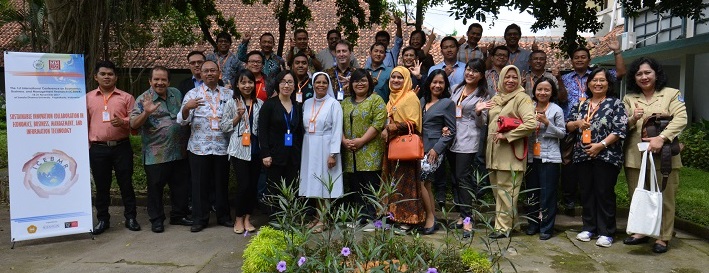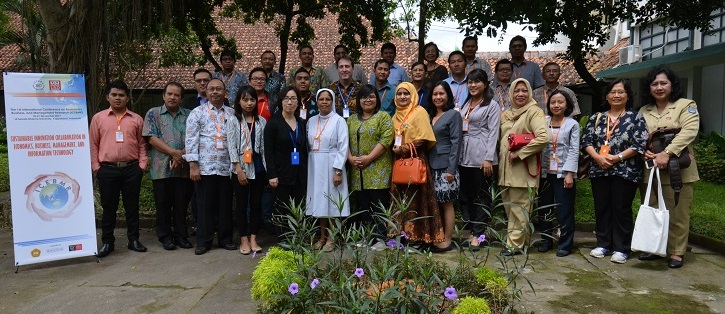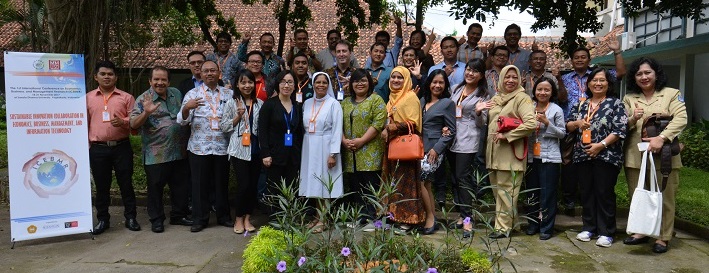 Magister Manajemen USD News, Master of Management Department, Economic Faculty, Sanata Dharma University, Yogyakarta has presented the 1st International Conference of Economy, Business, and Management Research (ICEBMR 2017) entitled “Sustainable Innovation Collaboration in Economics, Business, Management, and Information Technology”. The international conference was conducted on 18-21 November 2017. In this conference, there were 6 influential keynote speakers from various countries. Below is the list of keynote speakers and their topics:
- Dr. Patrick Ziegenhain, Visiting ProfessorAsia-Europe Institute University of Malaya Kuala Lumpur. Topic: The Future of Regional Economic Integration in ASEAN and the EU after Brexit.
- Satya P. Chattopadhyay, Ph.D from USA (Chair Marketing, Department Kania School of Management, University of Scranton, Pennsylvania, USA). Topic: Digital Marketing Issues and Challenges in Global Marketplace.
- Drs. J. Eka Priyatma, M.Sc., Ph.D from Indonesia (Information Engineering Department of Sanata Dharma University; President of Sanata Dharma University, Yogyakarta). Topic: Understanding Technological Innovation from Actor Networking Theory (ANT) Perspective.
- Tamako Watanabe from Japan (Specialist of Social Impact Business, the Japan Research Institue, Ltd.). Topic: Transforming and Shaping Communities through Sustainable Social Entrepreneurship.
- Dr. Agapito (Pepe) Rubbio Jr. DBA from Philipines (Dean of College of Business and Accountancy, Ateneo de Naga University). Topic: Bicol Business Boomers: The Context of Regional Enterprise Development Perspectives.
- Dr. Dick Sibbernson from USA (Retired Executive vice-president of AT&T Corporation, USA). Topic: Managing Human Resources: Developing Future Global Business Leaders.
Through this summary, we try to summarize and infer some lessons from the keynote speakers’ presentation.
Dr. Patrick Ziegenhain presented his study that concerns about the recent phenomenon of European Union (EU) and ASEAN Economic Community (AEC) economic integration phenomenon. The study finds that countries with a high degree of intra-ASEAN trade will benefit most from the AEC. Even though, the volume of intra-regional trade of ASEAN is very low. The stakeholders of AEC must give priority on the AEC infrastructure development as soft and hard-infrastructure to support intra-ASEAN trade growth is lagging behind compared to other regions, given the various technical, political, social, cultural infrastructures condition. Related to the EU economic integration, there is some potential opportunities (especially in making progress on long needed reforms to support integration) and threats (especially for losing great some of its economic, military and pollitical power) as the effect of British exit (Brexit). Brexit will be more a damage for the UK’s economy rather than for the EU, which is nevertheless weakened. In comparison with the EU phenomenon, the AEC has a greater potential for economic growth with rising population, rising incomes, growing consumer sophistication, and improving infrastructure ASEAN will continue to be one of the most rapid growing regions in the world. The AEC will foster intra-ASEAN trade and offers economies of scale to attract foreign investors. The EU will stay a global economic super power, but it will occupy with its internal struggles (including Brexit) in the near future. However the phenomenon of EU integration will be a valuable lessons for AEC development.
The condition in ASEAN that mentioned above, especially the low volume of intra-regional trade among ASEAN countries hopefully can be increased using digital strategy. Mr. Satya said that digital strategy can be classified into two kinds of strategies, they are: offensive digital strategy and defensive digital strategy. Offensive digital strategy could be in form of: platform play, new marginal supply, and digitally-enabled products and services such as banking and its payment systems. Meanwhile, the defensive digital strategy could be in certain form, such as: re-bundling and customizing, digital distribution channels, and cost efficiency. Digital transformation should make company to think about digital transformation of the customer experience. It means that company should know more about their customers and also they should know about the services that customers need.
Countries also should have an understanding about how to build sustainable social entrepreneurship movement. According to Tamako Watanabe, it needs a comprehensive study of social entrepreneurship and innovation ecosystem before social business innovation come to the implementation. It follows some procedures, starting from proposal of hypothesis of business model, establishment of consortium, product distribution and marketing test, start-up or pilot project, and implementation. Assesment of the needs in each maturity stage is also crucial. The existence of supporting network and various incentives form will be an important factor that determines social business innovation success. Social business concerns about the impact of their actions on society so that it is important to know how social business impact society well-being. That is the reason why a social impact evaluation must be incorporated in social business performance report.
Continuing from Tamako Watanabe’s research about some countries in Asia regarding social business and social impact, Mr. Agapito Rubio conducted the research in Philippines to investigate cases of outstanding entrepreneurs who had unique experiences and balanced perspectives on the practice of entrepreneurship—six of the Bicol Region’s outstanding entrepreneurs who were recognized as Halyao Awardees by the Metro Naga Chamber of Commerce and Industry in the Philippines between the years 2012 and 2013. Utilizing the lens of McKinsey’s 7S Model (system, strategy, structure, skills, style, staff, and shared values), the environment of the object of study were analyzed. Based on the finding, the author proposes that participants in the study have developed advanced entrepreneurial worldviews that underlie their motivation and capacity for effective entrepreneurial leadership. Successful entrepreneur also needs a good leadership inside of them. According to Dr. Dick Sibbernson, there are two main pillars of leadership DNA: character and competence. Besides the two characters, there is also another factor that completes them, the implementation of two main pillars to diagnose, design, and deliver solutions to global and local situations. If an organization or a company wants to get an outstanding business result, there should be an outstanding leadership. To be an outstanding leader, the new leadership skills that should be fulfilled are: skills to re-imagine jobs effectively and quickly; skills to be a “master architect” and “teacher” of organization design; skills to create effective work “Eco-System” which attract, retain, engage, and grow talent’ and skills to much more than “Business as Usual” identification, assessment, and evaluation tools.
Considering about the importance roles of social factors in the process of technological innovation, Mr. Eka Priyatma proposed Actor Network Theory (ANT). This theory has two assumptions. First assumption is everything in this world is just an effect of networks. The next assumption is the existence of superior actor(s) who can maintain and utilize the network. The actors here are all entities in the world, both human and non-humans. The actor(s) who or which control the mechanism called OPP (Obligatory Passage Point). Some researchers also said that ANT uses a radical assumption that there is no distinction between human and non-human entities in determining the stability of a social reality. There are four stages in ANT translation process to identify a social or technical reality ends up being stable or un-stable for a certain period of time. The stages are: problematization, interessement, enrolment, and mobilization.
To end this summary, we hope that from this first international conference, our knowledge about economics, business, management, information technology, and other body of knowledge are being updated while the collaboration among them are realized. We also hope this conference will bring an inspiration to further researches, academic forums and practices which consider the roles of all economic actors and the incorporation of economic, business, social and interdisciplinary approach to responding the future global issues and promote sustainable development goals.


|
